The area that was to become Lancaster County began to take shape after the turmoil of the Revolution. A law was passed in 1785 that provided for periodic courts within each of the thirty four newly created counties with in
South Carolina. It is this date to which Lancaster County can point its official beginning. The country originally included what is present day Kershaw County. The 1785 act called for the erection of a court house, stating “a goal (jail), a pillory, a whipping post and stocks.” At the time the court was being held at the home of Mr. John Ingram, near Hanging Rock. The center of the new county was to be around present day Heath Springs or Kershaw. Having been used to having court in their town, the citizens of Camden worked for the creation of Kershaw Country in 1791 and made Camden the county seat. By doing this, Hanging Rock was no longer centrally located and the court was moved to the property of Nathan Barr, just north of present day Lancaster. Shortly thereafter, John Simpson gave land for the building of a courthouse. A log building was constructed near the site of the present day courthouse. The village grew up around Barnettsville and Lancaster County has its first community which could be described as a town with some justification. A second court house was built in 1801, the town’s name was changed to Lancasterville and a plat was drawn. The third court house was built in late 1827, and Lancaster was described by Robert Mills as a village with thirty houses and store, five streets running each way at right angles. The town continued to grow around the courthouse with houses up and down the present Main Street.
An important event in the early history of the county was the visit of President George Washington in 1791. He passed through on his
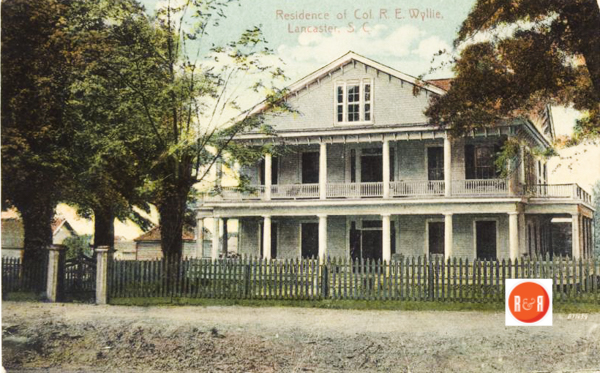
Col. R. E. Wylie’s home in downtown Lancaster, S.C. Courtesy of the Davie Beard Postcard Collection – 2017
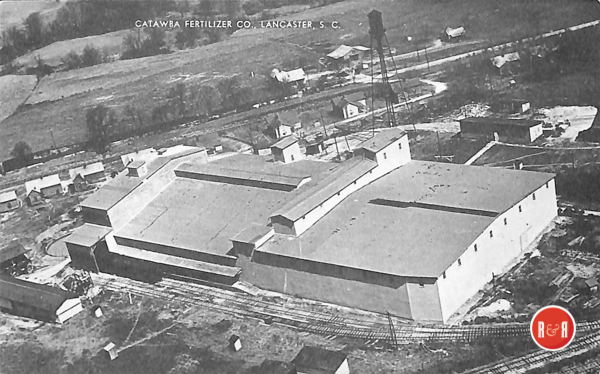
Image of the Catawba Fertilizer Company building. Courtesy of the AFLLC Collection – 2017
southern tour using the route of the old Catawba Trading Path. Washington kept a very detailed journal of his travels and described the trip from Columbia to Camden as “goes over the most miserable pine barren I ever saw”. He was pleased at the better quality of the land as he moved through Lancaster County. On May 26, 1791 Washington spent the night at the home of James Ingram at Hanging Rock, this home was later burnt by Sherman’s troops during the Civil War. He inspected the site of the Battle of Hanging Rock. Then the next morning he traveled through the countryside to Barr’s Tavern, which is just north of present day Lancaster. May 27 he spent the night at Major Robert Crawford’s home in the Waxhaws. There he was greeted by local residents and a delegation of Catawba Indians seeking assurance that their lands would not be taken away. There was a political element to Washington’s southern tour. He wanted to strengthen the loyalty of the citizens who were nervous about the new growing federal government.
Although primitive by today’s standards, transportation was improving. Bad weather often made roads impassable. Efforts began in the early 1800’s at the state level to improve road conditions. The rivers posed significant barriers to transportation but ferries, established by private businessmen, proved a solution to this problem. There were a number of ferries on the Catawba and Lynches Rivers, the McClanahan’s Ferry, being one of the most important, was about five miles above the Landsford on the Catawba. Later called Cureton’s Ferry and Indian Ferry, it was used for about 200 years.
The economy of Lancaster County, especially agriculture, underwent profound changes. Most residents, for the first few decades after settlement, were subsistence farmers. They grew a variety of crops and sold whatever could be spared. The cotton gin led to a shift toward one crop farms and a reliance on slave labor. Cotton became a mainstay of the economy. Lancaster County began to resemble the slave based economy of the lowcountry, than the previous small independent farmers. As lands became available in the slave states of Alabama, Mississippi, Tennessee and Arkansas, large numbers of farmers from Lancaster Counties moved west. The population in Lancaster began to be weighted more toward slaves than small farmers.
Impressive gains in agriculture arose from cotton culture and its rewards of wealth to a few large scale farms. There was a beginning of an architectural sophistication among churches and houses were built larger and more opposing. The most impressive buildings in the county built were the court house and jail designed by Robert Mills. There may be no structures left in the county that are connected with the life of slaves. But a number remain from the period from before the Civil War that show the rich heritage and age of prosperity had for the few.
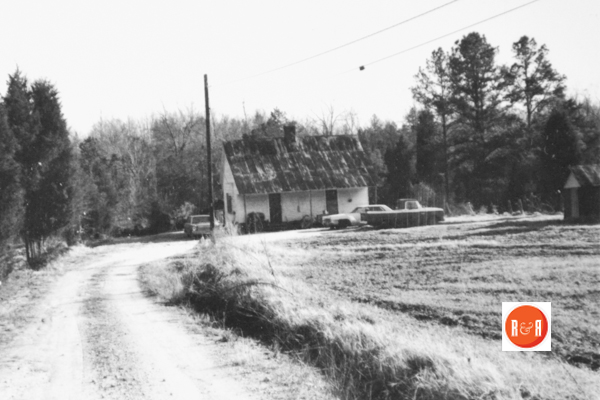
Typical of African American rural housing of the early to mid 20th century in rural Lancaster Co., SC – Courtesy of the S.C Department of Archives and History
When South Carolina seceded from the Union in December 1860, Lancaster County was ready to take part in the events to come. The county had become a plantation society with a number of planters who owned large work forces of slaves. While most of the whites were farmers or craftsmen, the institution of slavery had instilled fears of slave uprisings that kept the local militias active.
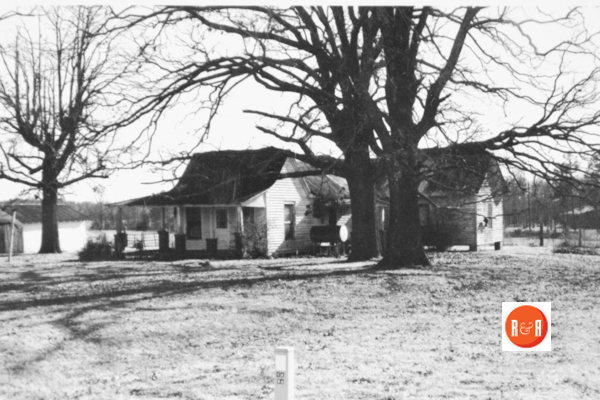
Very typical farmstead in Lancaster County’s rural areas in ca. 1910. Courtesy of the South Carolina Department of Archives and History
Lancaster County men were ready and eager to march off and put a quick end to the “northern aggression”. Companies were formed in several parts of the county. While Lancaster soldiers faced the same dangers and hardships that all the other Confederate soldiers faced, Lancaster County was not involved in any major actions during the war. For years to come, the loss of so many men would have a profound effect on the development of the county. Men of every class were lost to the war, many who had never owned a slave. At home women made heroic efforts to raise children, make a living and hope for the best. In her famous diary, Mary Boykin Chestnut wrote “there were parts of Lancaster without a dozen white men of any age left at home Fighting Catawba’s! Children of the stout hearted Seceders and no means a slave holding district”. The slaves themselves were in an unsure position. Hearing rumors of emancipation they were still under the control of their white masters. Most simply went about their daily tasks during the war, uncertain of what lay ahead and ill prepared for a new order of things.
The Rock Hill Herald reported on Nov. 1, 1883 – “Edmund Porter, a colored man living in the Waxhaws, had his left hand caught in the saws of Mr. Ed Mobley’s gin on Tuesday of last week. The thumb was cut off and the hand badly cut.”
In early 1865, elements of Sherman’s ragged army passed through Lancaster County. Several first person accounts exist of the confusion, fear, and terror, which accompanied the movement of this force. The main forces were preceded by waves of marauding ruffians. Houses were rifled, all valuable possessions taken and plantations in the countryside burned. General Kilpatrick’s cavalry made its headquarters in the town of Lancaster for several days, with Kilpatrick and his top officers taking over the home of Mr. D.W. Brown on Main Street. While Kilpatrick and his officers seemed to have treated the citizens with some degree of respect, most homes were looted by some element of the army.
The Lancaster News of June 24, 1924 reported – “Marion Allison returned home recently from Ga., where he taught school near Macon. He has pursuing a correspondence course in law and will continue to read law in the office of his father, Attorney R.B. Allison until ready to go before the supreme court for examination.”
The force set fire to the courthouse and jail before leaving Lancaster. At the Courthouse the official papers were collected and thrown into the lower rooms and set on fire. Citizens discovered this and were able to extinguish the fire before the building was destroyed, but the probate court and equity court papers were lost. Turpentine balls were lighted and thrown on the roof of the jail. This too failed to destroy the structure and Lancaster is fortunate to have saved these impressive buildings.
Under pressure from Wheeler’s cavalry, the federal troops moved out of Lancaster and to the east. The destruction that they left behind was not as extensive as in some other areas of the state, but many of the beautiful old homes were lost.
The years following the war were lean ones. Many of the young men, who would have normally been taking their places as leaders in businesses, church life and in the community, had been lost to a defeated cause and there was no one there to take their place. Property was destroyed or stolen. The large landowners had lost their labor force and had to forge a new system of agriculture. The former slaves, who were now free and had rights under Reconstruction, were set adrift in a new world. The world had turned upside down for whites and blacks. When General Wade Hampton was elected in 1876 the years of Reconstruction ended for South Carolina.
At this crucial point in the life of South Carolina and Lancaster County, new beginnings were necessary. The old system of slavery and agriculture had passed away and white and black farmers now struggled to make the land support new families in a period of uncertain economic conditions. The area needed railroads, bridges, and other public improvements and in needed new efforts to change the economy. The South however was depleted and lacked the capital to lift herself.
We are accustomed in our current century to consider out time as a unique era of great change. However, there have been other periods in our history when change was rapid hand had a dramatic effect on society and the face of the land. The last two decades of the nineteenth century was such a time. The veterans of the Confederacy and their sons worked alongside the freed slaves and their sons to bring about a new order. Merchants became more important to the economy as they extended credit to farmers and helped build a stable society of small farms and crafts men. Many blacks became landowners for the first time, although many others were forced to accept a system of sharecropping which all too closely resembled a system of slavery. Cotton production grew but the price won by farmers was not always certain and not always sufficient to cover costs. The cotton was the raw material which the South could use to build for the first time a manufacturing economy.
In the 1870’s and 1880’s in many areas if the piedmont where water was plentiful, areas began experimenting with cotton mills. Col. Leroy Springs had developed as a leading merchant and cotton buyer. Under his leadership, the Lancaster Cotton Mill was organized in 1895 began operations in 1896. Today, the impacts that the mills had on the economy, social structure, and urban structure can still be felt. The steady living of industrialization brought many former farmers into the “mill villages”. Along with the progress came the child labor and bad working conditions, and other unpleasant things. Under Col. Springs and his son Elliott White Springs, a sincere concern for the welfare of the workers led to many efforts to make their lives more meaningful and softened the face of the new age. The Development of Springs Mills, later Springs Industries, has had a most profound impact on Lancaster County.
After the war, the social order between blacks and whites had to be established. This was not an easy task. The turmoil of Reconstruction had led to hardened lines and racial strife with the Ku Klux Klan becoming active in most of the piedmont counties including Lancaster. Although blacks still continued to seek power once the white power structure had been reestablished in 1876. Several blacks were killed in Lancaster during a series of rallies during the election of 1882. Many blacks struggled with small farm or as sharecroppers. In 1888 the Colored Farmers Alliance was organized in the Cedar Creek community with the object of raising wages for cotton pickers. Black churches became an important part the social fabric for the black community. Blacks were not welcome as workers in the new textile mills and thus remained outside the mainstream of economic progress. By the 1880’s they began to move away seeking more opportunity in the growing cities or in the north. This movement continued and intensified in the early twentieth century.
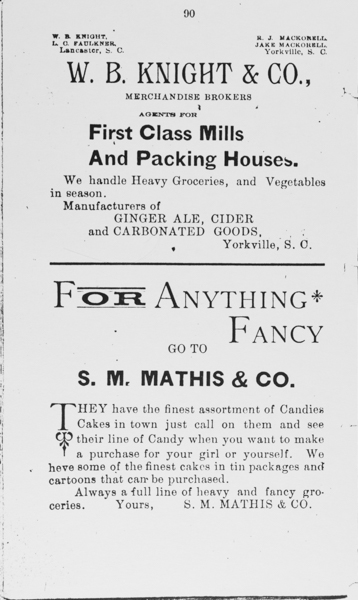
Ad from the Lancaster County Promo Booklet, ca. 1900 Courtesy of the AFLLC – Pettus Collection 2020
During this time the architecture of Lancaster County changed as well. Much of the fabric of downtown Lancaster dates from the late 1800’s and early 1900’s and is now an important National Register historic district. Structures in Heath Springs and Kershaw remain to remind us of the early days of these communities. Farm houses throughout the county date from this period, although many are sadly deteriorated. Commercial architecture during this period reflected a new sense of power, wealth, and boldness. The Springs Mill in Lancaster widely boasted as being the largest textile mill in the world was itself a citadel of manufacturing. The Springs Block on Main Street in Lancaster which dates from 1905 is proud of the rich brickwork and facades of the period. The Victorian period also produced some exuberant residential architecture especially in growing towns. Rural homes tended to remain closer to the farmhouse styles of the past. The early 1900’s led to a revival of the classical style of architecture and many homes with columned porticos grace the county from this period.
The rise of the merchants and the mills in the late 1800’s led to the more rapid growth of the towns. Another important factor was the coming of the railroad. In 1887, a line was extended north from Camden through Lancaster County into North Carolina. A station was established halfway between Camden and Lancaster and soon a new town was established. The town was named for General J. B. Kershaw of Camden, a hero of the Civil War. Kershaw grew rapidly reaching a population of around 1,500 by 1900 and some of the houses from that early period remain. The Kershaw Oil Mill, begun in 1902 and the Springs Cotton Mill in 1912 added to the progress of the town. In 1897, a fire that started at a bakery destroyed many of the wood commercial buildings and they were replaced by brick buildings. Heath Springs had its origins in a well-known mineral spring first known as Hanging Rock Mineral Spring, which was described by Robert Mills in 1826. An inn was opened in 1856 and was a popular resort before the Civil War. It is possible that the old inn was burnt by Sherman’s raiders. The property was sold in 1888 to B.D. Heath and became known as Heath Springs. When the railroad came through the town was assured of a more stable growth pattern and today it is a pleasant small town.
Although today there are only three incorporated municipalities in Lancaster County there have been many communities in the past which could be considered villages. Some of them existed only as a general area centered on a church or store. Others had a post office while others developed onto recognizable villages.
Pleasant Hill, like Kershaw, became incorporated shortly after the railroad came through in 1888. It was known as the highest point between Rock Hill and Camden. Later it lost its incorporated status but it continues today as a substantial community. Elgin is a community which grew up around St. Lukes Methodist Church. Riverside first known as Lindsay Post Office, grew alongside the railroad in the Waxhaws. Van Wyck, originally called Heaths is also on the railroad and developed as a trading post for the upper end of the county. Ashe’s Brickworks provided an employment base for Van Wyck.
On Jan. 25, 1893 the YV Enquirer reported: “Work began three weeks ago on the new buildings for the Rock Hill Buggy Company. The new complex will cover three acres. The main building will be two stories and 50-200 feet. The blacksmith shop and woodshop buildings will be 40-180 feet. The boiler room will be 15-40 feet and the dry kiln will be 30-50 feet. An additional building will house the spoke and handle machinery recently purchased from the Lancaster Company.”
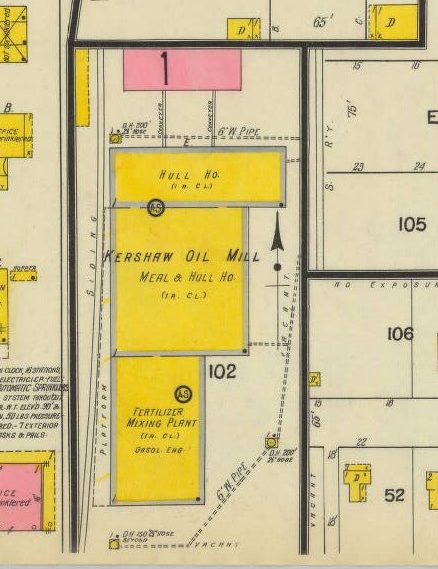
1916 Diagrams of the Kershaw Oil Mill.
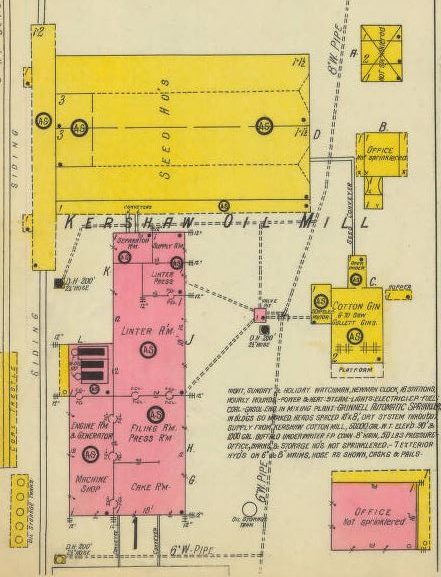
Many communities have either declined substantially or disappeared altogether. In 1850, there were ten communities with post offices in the county: Belair, Cureton’s Store, Pleasant Valley, Jacksonham, Lancaster, Longstreet (Belltown), Dry Creek, Pleasant Hill, Hanging Rock, and Hickory Head (Taxahaw). Kingsbury was and important community on the Catawba River across from Rocky Mount in Chester County. Kingsbury existed in the early 1800s because it provided a place for putting cotton on the river for shipment to Charleston, avoiding the great falls of the Catawba. Osceola, once a village and post office had twenty houses, a church and a school. Dwight was a promising community halfway between Lancaster and Tradesville in 1900. Taxahaw and Tradesville both failed to grow and develop into sizable towns. Other communities include Belair and Pleasant Valley in the Indian Land area and Belltown and Stoneboro in the southern part of the county.
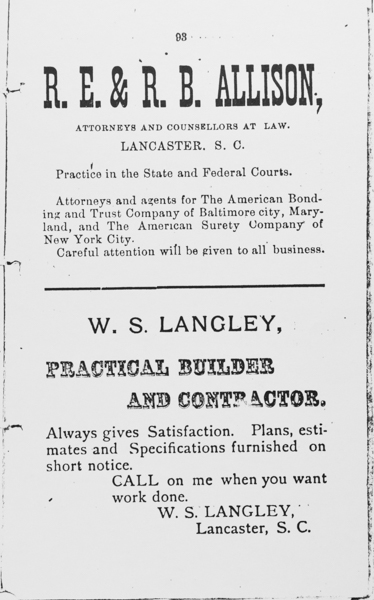
Ad from the Lancaster County Promo Booklet, ca. 1900 Courtesy of the AFLLC – Pettus Collection 2020
The Town of Lancaster experienced strong growth in the late 1800’s and early 1900’s George W. Malone described the transformation as it was taking place in 1900. “The growth of this delightful and flourishing town has be rapid, progressive, and astounding.” Many brick buildings were present in the downtown area, filled with establishments doing booming trade. Streets had been cleaned and sidewalks has been paved, street lamps were in place, and schools and churches were strong. He described the black population as “doing well in Lancaster…they are progressive and intelligent.” There were twelve major streets and some fine new homes. The Lancaster Cotton Mills stood south of Lancaster as a model of industrial efficiency. The “factory hill” had 174 neat white and yellow frame housed with 1,400 inhabitants who were awoken at 4:30 in the morning each day by the factory whistle. Further progress in Lancaster led to a report in 1923 that Main Street was paved for on half mile south of the courthouse and there were over nine miles of cement sidewalks.
Lancaster County continued to grow and develop into the twentieth century. Along with the rest of America it experienced the, Great Depression, the World Wars, the Civil Rights movement and the modern period of industrial expansion and diversification. The expansion of the Charlotte urban area is a major factor in the northern part of the county. The challenge facing the citizens of Lancaster is how to provide for the continued growth while preserving the evidences of a proud and important heritage.
“Among recent manufacturing enterprises may be mentioned a spoke and handle factory with Mr. L.C. Payseur as president, a manufacturing and repair factory by J.M. Hood & Co., and flour and grist mill by J.A. Chisolm. Another new enterprise is the Bank of Lancaster, Leroy Springs, president; D. A. Williams, vice president; and W.C. Thompson, cashier. The books of subscription to the People’s Loan and Savings Bank are now open. In this enterprise Senator J.B. Erwin, Capt. H.B. Patrick, and W.D. Lemmond are active. The first of these expects to be ready for business by August the 15th, and it is hoped that the other will soon be opened.
A cotton mill is being discussed, and perhaps a cotton seed oil mill will come in due time.
The Yorkville Enquirer reported on July 23, 1885 – “A fire in Lancaster was discovered on the second floor of the frame building belonging to Mr. James F. Hunter on Main Street. The store of W.F. Swaringn which occupied the Hunter Building was destroyed. The fire spread rapidly to buildings belonging to Mrs. M. A. Cureton, and S.C. Shaffer. In the Shaffer Building the barber and tin shop belonging to the Bennett Brothers was destroyed. Damage was also done to brick building of L.C. Payseur on the South side and the brick store of Smyth and Adger of Charleston on the North side. The stock of goods belonging to B.F. Welch in the Smyth and Adger building was also damaged. The Crockett House on the opposite side of the street was scorched.”
The Rock Hill Herald reported on July 30, 1885 – “Mr. Jordan A. Hasseltine has died at Lancaster. For the past two years he kept the Catawba House.” The Yorkville Enquirer added: “He came from N.H. some forty two years ago and had been a merchant in Lancaster.”
The Rock Hill Herald on April 21, 1887 announced – “A fire in Lancaster on April 14 broke out in the livery stable of Hickson and Walker. The fire was caused by a lantern used by Mr. Joseph Walker while feeding the stock. The stable was burned as well as a small house used by the town as a guard house and a large building in the rear of the Catawba House. The horses and the omnibus were saved but all the buggies, wagons and harness were lost. The total loss was about $7,000.”
The Lancaster News of March 2, 1901 reported – “The Lancaster City Council has ordered removal of wooden awning frames, store signs, and trees on Main Street so the work of cement sidewalks may begin soon.” On June 17, 1903 – “The work of laying cement pavement on the east side of Main Street between Dunlap and Gay Streets is almost complete and the work on the westside will begin at once.”
On May 5, 1906 the paper reported – “The sidewalk on Main Street will be cemented in front of the Springs Block.”
The municipal government is in the hands of Lancaster’s most wide-awake citizens: Mayor, L.C. Payseur; wardens, W.W. Perry, M.F. Jones, T.S. McManus, and J.F. Hunter. The postmaster recently appointed has taken charge of the office, which will continue to be managed by Capt. John W. Hamel. There are two weekly newspapers published here, the Lancaster Review and the Lancaster Ledger. The Review is owned by Riddle & Connors and edited by Major Charles T. Connors. The Ledger is owned and edited by D.J. & L.S. Carter. They are both model country newspapers. The Ledger has recently put in a large Campbell cylinder press. Major Connors, of the Review, is a popular Representative in the Legislature, in which he has done effective service for his county and made an enviable name for himself. A still higher sphere of usefulness is predicted for him by those who know him.
The Lancaster Guards, Capt. John W. Hamel, is a credit to the town. The Rock Hill Herald reported on Oct. 16, 1918 – “James H. Hamel, one of the most prominent and influential businessman in Kershaw, has died of the flu and pneumonia. He was a 1905 graduate of Wofford College and was associated with his father in the publication of the Kershaw Era. He was in the process of being drafted for war service.
The following firms transact a large volume of business: T.M. Fitzpatrick & Bro.; Heath, Springs & Co.; Wm. Ganson; W.D. Lemmond; L.C. Payseur; Cunningham Bros.; Cloud & Allison [Allison]; Racket Store, W.B. Knight, manager; J.E. Taylor; W.H. Crockett; Jones & Co.; G.F. Payseur; T.H. Davis; W.A. Davis, artist; T.S. McManus, millinery; Miss Jane Stevens, millinery; J.F. Mackey & Co., drugs; Crawford Bros., drugs; Long & West, bar; Clark & Wharlow, bar; S.C. Schaffer, bar; H.J. Gregory & Co., livery and sale; J.M. Hood, livery and sale; Hickson & Walker, livery and sale; F. A. Dual, repair shop; W.D. Drennan, repair shop; Richard Young, market; and J.M. Summey, barber. The Catawba House, J.J. Perry, proprietor, and the Crockett House, Jones Crockett, proprietor, furnish ample accommodations for the travelling public.
The Yorkville Enquirer reported on Jan. 21, 1891 – “One of Rock Hill’s enterprising firms, F.O. London and Co., has purchased the entire stock of Gordon Cunningham and Brothers of Lancaster and removed it to Rock Hill.”
The Herald on Jan. 15, 1902 reported, “Mr. E.E. Cloud will move his wife and two children to Rock Hill, and has rented the house on Johnston Street recently erected by the Messers. Greene Family. Mr. Cloud is a native of Rocky Mount in Fairfield Co., S.C. and has lived in Lancaster for fifteen years. His business here has been successful and he is now moving his family here.”
The Herald reported on May 20, 1903 – “Mr. E.E. Cloud has rented one of the Cunningham Store Rooms in Lancaster and will open up a mercantile. This will be a branch of the Rock Hill business and will be Mr. Tom Wylie will be in charge.”
At the Lancaster Bar may be found as bright talent as there is in the State. R.E. Allison, J.D. Wylie are the oldest. Then come sons of such worthy scions, R.B. Allison and R.E. Wylie. Others are Ernest Moore, M.J. Hough, Charles T. Connors, T.S. Carter, Ira B. Jones, B.J. Witherspoon, who is trial justice, and T.Y. Williams. The physicians are: J.F. Mackey, Mart P. Crawford, W.M. Crawford, T.J. Strait, J.H. Witherspoon, and Robert P. Witherspoon. The educational interests are in a prosperous condition. The Franklin Institute, President J.B. Baird, has closed a prosperous year. The building is being enlarged, and the friends of the school expect a material increase of patronage the coming session. Prof. Baird is doing excellent work.
The pride of Lancaster is her churches. There are four white and two colored. The Methodists have recently erected a handsome brick structure, and they are having, under the pastorship of the popular, eloquent Rev. P.F. King, a most prosperous year. Their Sunday-school is under M.F. Jones, superintendent. The Baptists are growing under the effective labors of the devoted Rev. A.J. Stough. Mr. W.J. Long is superintendent of the Sunday-school. The Presbyterians, the Rev. C.W. Humphries, pastor, are moving along with the others. R.T. Beaty, superintendent of Sunday-school. The Associate Reformed Presbyterians have lost their pastor, the Rev. R.Z. Mills, by death, and have not yet secured another. Ira B. Jones has charge of the Sunday-school. There is one colored Baptist Church and one A.M.E. Zion Church.
Lancaster is surrounded by fertile farms and rich mines. Her prosperity is solid and the heights not yet reached.
The town has produced the illustrious Dr. J. Marion Sims* and the county claims the birthplace of “Old Hickory” the brave Andrew Jackson. In the persons of Lancaster’s prominent citizens I see worthy followers of these great men.”
Reprinted in part, from South Carolina in the 1880s: A Gazetteer by J.H. Moore, Sandlapper Publishing Company – 1989
Stay Connected
Explore history, houses, and stories across S.C. Your membership provides you with updates on regional topics, information on historic research, preservation, and monthly feature articles. But remember R&R wants to hear from you and assist in preserving your own family genealogy and memorabilia.
Visit the Southern Queries – Forum to receive assistance in answering questions, discuss genealogy, and enjoy exploring preservation topics with other members. Also listed are several history and genealogical researchers for hire.
User comments welcome — post at the bottom of this page.
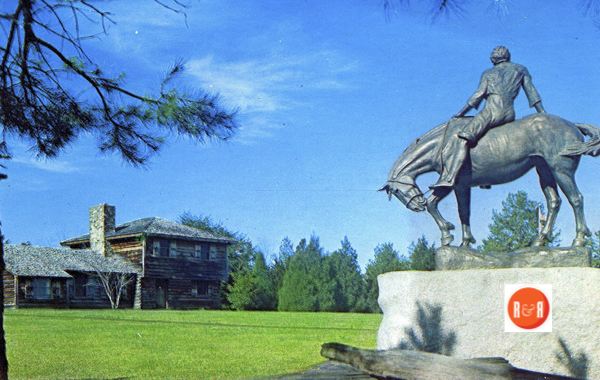

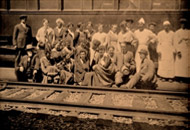
Share Your Comments & Feedback: